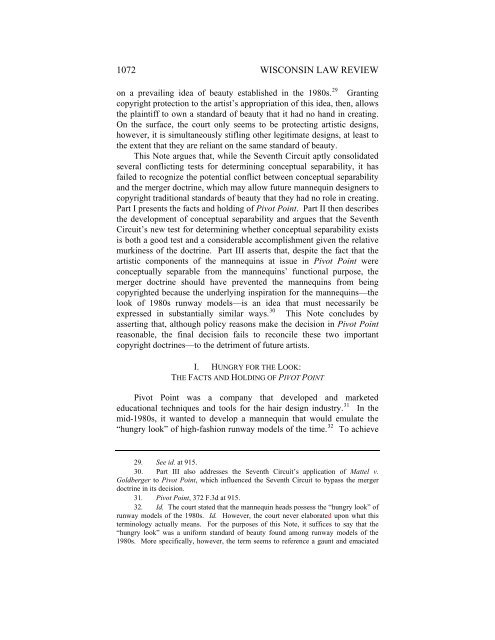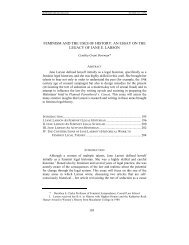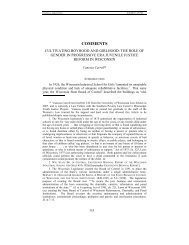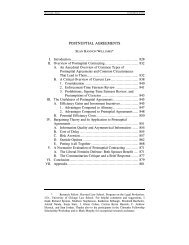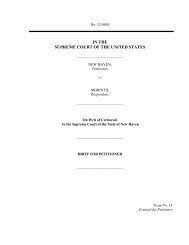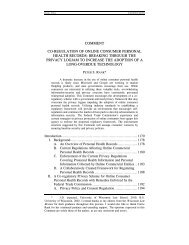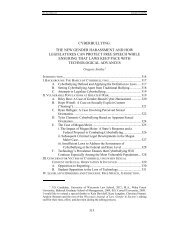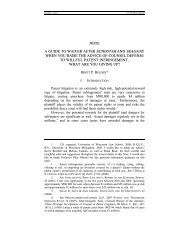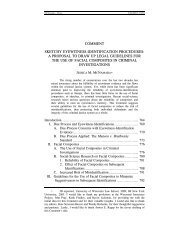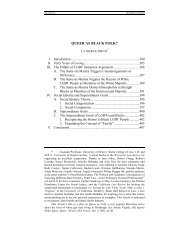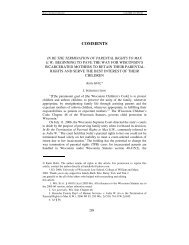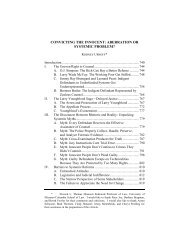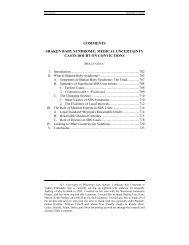Stealing Beauty: Pivot Point International v ... - UW Law School
Stealing Beauty: Pivot Point International v ... - UW Law School
Stealing Beauty: Pivot Point International v ... - UW Law School
Create successful ePaper yourself
Turn your PDF publications into a flip-book with our unique Google optimized e-Paper software.
1072 WISCONSIN LAW REVIEW<br />
on a prevailing idea of beauty established in the 1980s. 29 Granting<br />
copyright protection to the artist’s appropriation of this idea, then, allows<br />
the plaintiff to own a standard of beauty that it had no hand in creating.<br />
On the surface, the court only seems to be protecting artistic designs,<br />
however, it is simultaneously stifling other legitimate designs, at least to<br />
the extent that they are reliant on the same standard of beauty.<br />
This Note argues that, while the Seventh Circuit aptly consolidated<br />
several conflicting tests for determining conceptual separability, it has<br />
failed to recognize the potential conflict between conceptual separability<br />
and the merger doctrine, which may allow future mannequin designers to<br />
copyright traditional standards of beauty that they had no role in creating.<br />
Part I presents the facts and holding of <strong>Pivot</strong> <strong>Point</strong>. Part II then describes<br />
the development of conceptual separability and argues that the Seventh<br />
Circuit’s new test for determining whether conceptual separability exists<br />
is both a good test and a considerable accomplishment given the relative<br />
murkiness of the doctrine. Part III asserts that, despite the fact that the<br />
artistic components of the mannequins at issue in <strong>Pivot</strong> <strong>Point</strong> were<br />
conceptually separable from the mannequins’ functional purpose, the<br />
merger doctrine should have prevented the mannequins from being<br />
copyrighted because the underlying inspiration for the mannequins—the<br />
look of 1980s runway models—is an idea that must necessarily be<br />
expressed in substantially similar ways. 30 This Note concludes by<br />
asserting that, although policy reasons make the decision in <strong>Pivot</strong> <strong>Point</strong><br />
reasonable, the final decision fails to reconcile these two important<br />
copyright doctrines—to the detriment of future artists.<br />
I. HUNGRY FOR THE LOOK:<br />
THE FACTS AND HOLDING OF PIVOT POINT<br />
<strong>Pivot</strong> <strong>Point</strong> was a company that developed and marketed<br />
educational techniques and tools for the hair design industry. 31 In the<br />
mid-1980s, it wanted to develop a mannequin that would emulate the<br />
“hungry look” of high-fashion runway models of the time. 32 To achieve<br />
29. See id. at 915.<br />
30. Part III also addresses the Seventh Circuit’s application of Mattel v.<br />
Goldberger to <strong>Pivot</strong> <strong>Point</strong>, which influenced the Seventh Circuit to bypass the merger<br />
doctrine in its decision.<br />
31. <strong>Pivot</strong> <strong>Point</strong>, 372 F.3d at 915.<br />
32. Id. The court stated that the mannequin heads possess the “hungry look” of<br />
runway models of the 1980s. Id. However, the court never elaborated upon what this<br />
terminology actually means. For the purposes of this Note, it suffices to say that the<br />
“hungry look” was a uniform standard of beauty found among runway models of the<br />
1980s. More specifically, however, the term seems to reference a gaunt and emaciated


